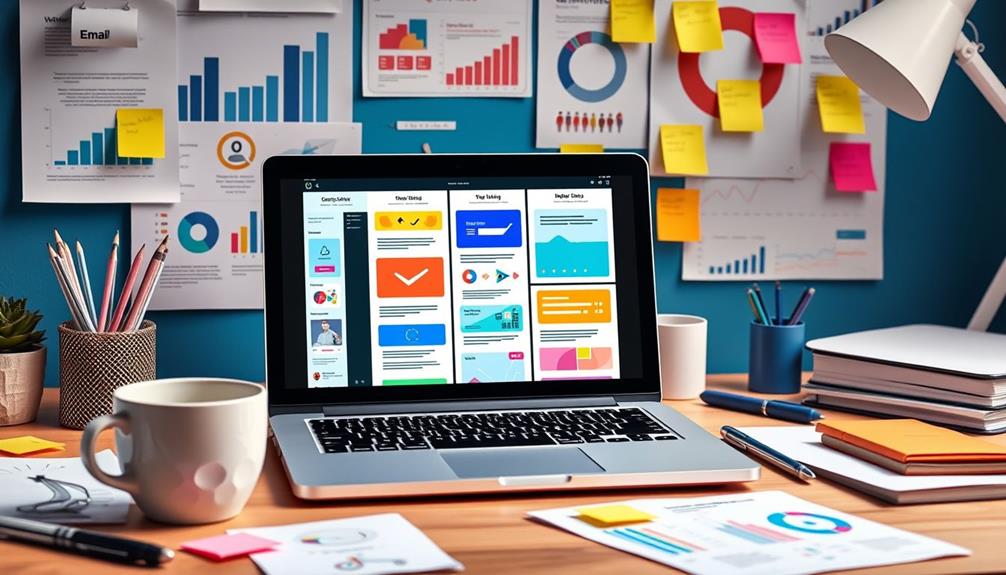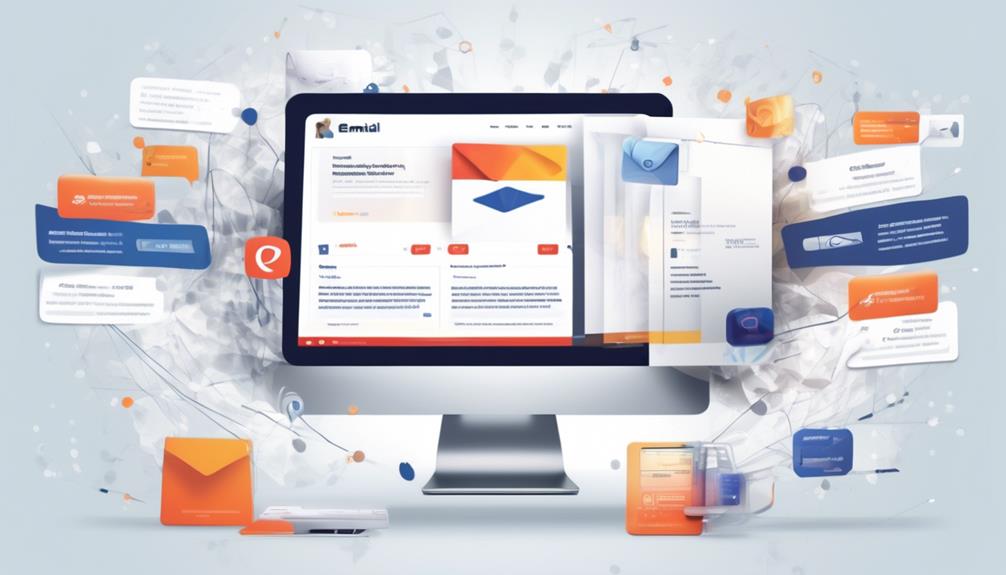An effective email marketing strategy involves understanding your audience and personalizing content. Start by segmenting your subscribers based on demographics and behaviors to boost engagement and revenue. It's essential to craft compelling subject lines—concise and enticing—to improve open rates. Use automation for triggered emails, like welcome messages and reminders, as they greatly increase engagement. Optimize for mobile by keeping subject lines short and using clear calls to action. Regularly assess your performance metrics to fine-tune your approach. Interested in tactics to elevate your emails further? Keep exploring strategies to enhance your email marketing success.
Key Takeaways
- Personalize your emails by using customer data to create relevant offers, enhancing engagement and increasing open rates by 26%.
- Segment your subscriber list based on demographics and behaviors to boost campaign performance, potentially increasing revenue by 760%.
- Optimize emails for mobile devices with short subject lines and bold CTAs to improve user experience and engagement.
- Implement automation for triggered emails like welcome messages, achieving high open rates and increasing revenue significantly.
- Regularly analyze and update your segmentation and content strategies based on performance metrics to meet evolving audience needs.
Email Marketing Overview

Email marketing is a powerful tool for businesses looking to connect with their audience and drive sales. As a key digital strategy, it involves sending promotional messages to subscribers, and it's no surprise that over 361 billion emails are sent daily. This figure is projected to hit 376 billion by 2025, highlighting the immense reach of email marketing.
To maximize effectiveness, utilizing effective email marketing strategies such as segmentation and personalization can lead to improved engagement and conversion rates. One of the standout features of email marketing is its incredible return on investment (ROI). On average, you can expect to earn $42 for every $1 spent, making it an essential channel for maximizing business revenue.
To enhance your campaigns, consider using personalized subject lines, which can boost open rates by 26%. Furthermore, segmented campaigns can lead to a staggering 760% increase in email revenue.
Mobile optimization is vital, as 46% of marketing emails were opened on mobile devices in 2022. Implementing responsive design guarantees your emails look great on any device, expanding your audience reach.
Importance of Personalization

Personalization is key to boosting your email marketing success, driving higher transaction rates and open rates.
By using effective techniques like personalized subject lines, you can make your emails more engaging right from the start.
Additionally, focusing on content relevance and tailoring your messages to meet audience needs can greatly enhance engagement.
Embracing these strategies not only helps you stand out but also meets your audience's preferences, leading to better engagement.
Benefits of Personalization
Engagement is key to successful marketing, and tailoring your emails can make a world of difference. Personalization isn't just a trend; it's a powerful strategy that can greatly boost your email marketing campaigns. For instance, emails with personalized subject lines can increase email open rates by 26%. When you consider that personalization can lead to 6x higher transaction rates, it becomes clear why you should prioritize this approach.
To illustrate the benefits, here's a quick summary:
| Benefit | Impact on Metrics | Importance |
|---|---|---|
| Higher Open Rates | 82% more likely to open emails | Captures recipient attention |
| Increased Transaction Rates | 6x higher transaction rates | Boosts sales and conversions |
| Enhanced Revenue | 760% increase in email revenue | Financial gain through tailored content |
| Improved Engagement | 89% of companies use A/B testing | Refines strategies for better results |
Effective Personalization Techniques
One of the most effective ways to connect with your audience is by implementing smart personalization techniques. Personalization in your email marketing strategy can dramatically enhance your results. For instance, tailored messaging can lead to transaction rates that are six times higher than non-personalized emails. By utilizing customer data effectively, you can create relevant offers that resonate with their unique preferences.
Additionally, understanding the significance of budgeting can help in crafting targeted campaigns that align with consumers' financial goals, as effective personal finance strategies can inform your messaging.
Don't underestimate the power of personalized email subject lines, either. They can boost your open rates by 26%, making recipients feel directly addressed. This is essential, especially considering that 70% of brands overlook personalization, leaving a significant opportunity for you to stand out.
Moreover, 91% of consumers prefer receiving relevant offers, which highlights the significance of leveraging customer data for targeted messaging. Regularly updating your personalization techniques based on customer feedback is important, as 83% of customers are willing to share their data for more tailored experiences.
Effective Subscriber Segmentation
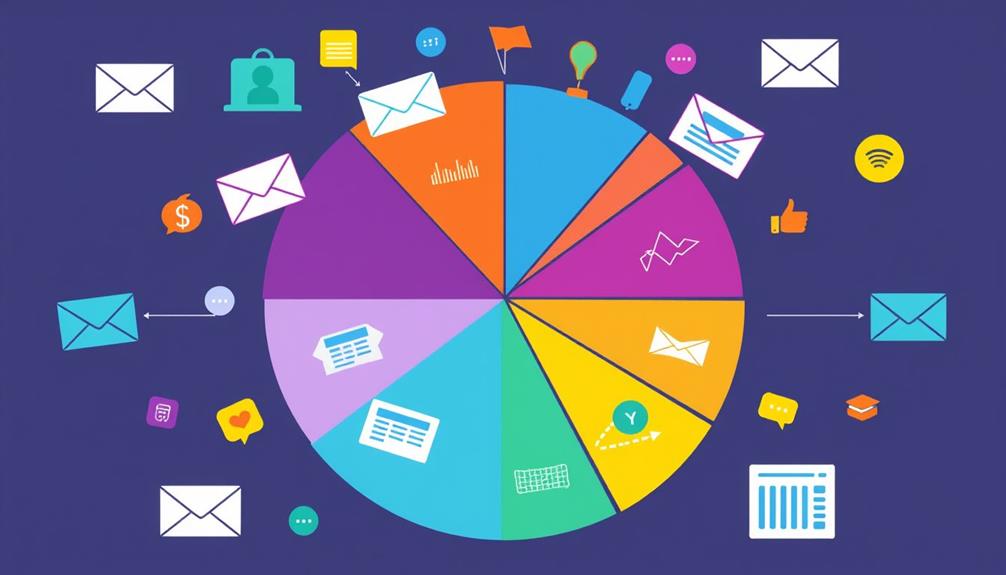
Effective subscriber segmentation is key to maximizing your email marketing success. By categorizing your audience based on demographics, purchase history, and engagement levels, you can tailor your content to resonate with their specific interests.
Utilizing best websites to earn money online can also help you understand what content drives engagement and conversions.
Importance of Segmentation
A well-executed segmentation strategy can dramatically enhance your email marketing results. By targeting specific subscriber groups, you can see a staggering 760% increase in email revenue.
However, it's surprising that 90% of email marketers don't segment their lists, which leaves a significant opportunity for you to stand out. Effective segmentation methods include categorizing subscribers by demographics, behaviors, purchase history, and geographic location.
This tailored approach allows you to create content that resonates with your audience, boosting engagement. Insights from utilitarian thinkers' declarations highlight the importance of considering individual preferences when crafting your messaging.
Research shows that segmented email campaigns outperform non-segmented emails in open rates, click-through rates, and overall conversions.
Incorporating segmentation strategies is vital for successful email marketing strategies. Regularly updating your segmentation to reflect changes in subscriber interests and demographics is essential for maintaining that engagement.
Effective Segmentation Strategies
Building on the importance of segmentation, implementing specific strategies can further enhance your email marketing efforts. Start by utilizing effective segmentation techniques, categorizing your subscriber segments based on demographics like age and location, as well as behavioral data such as purchase history and engagement levels.
This targeting is vital for creating segmented email campaigns that resonate with your audience. For instance, astrological signs and perceived beauty suggest that personal interests can greatly influence how subscribers engage with content.
Next, focus on delivering personalized content tailored to each segment. Doing so can lead to transaction rates that are six times higher than non-personalized emails. It's imperative to guarantee your messaging speaks directly to your audience's interests and preferences.
Additionally, embrace A/B testing within your segments. This approach allows you to refine your strategies continually, improving your open and click-through rates.
Monitor how different segments respond to various messages, and adjust your campaigns accordingly.
Regularly Update Segments
Regularly updating your subscriber segments is vital to maintain effective targeting. By refining your email segmentation, you can enhance personalized messaging that resonates with your audience, ultimately boosting engagement rates.
Most marketers overlook this critical step, leaving tremendous opportunities for you to capitalize on. As seen in recent developments in AI, targeted strategies can also lead to significant advancements in understanding consumer behavior, much like how AI develops a cure for the common cold surprised the pharmaceutical industry.
Here are some key benefits of regularly updating your segments:
- Improved Engagement Rates: Tailoring content to specific demographics and subscriber interests keeps your audience engaged.
- Higher Open Rates: Updated segments can lead to a 14% increase in open rates as the content becomes more relevant.
- Revenue Increase: Segmented campaigns can generate up to a 760% revenue increase, demonstrating the financial advantages of targeted strategies.
- Enhanced Campaign Effectiveness: Regularly reviewing performance metrics helps you adjust to changing subscriber behavior and preferences.
- Better Marketing Strategies: Ongoing segmentation adjustments guarantee your emails stay aligned with your audience's ever-evolving needs.
Key Performance Indicators

When it comes to measuring the success of your email marketing efforts, understanding key performance indicators (KPIs) is essential. These metrics help you gauge engagement and the overall effectiveness of your email campaigns.
Here's a quick overview of important KPIs to monitor:
| KPI | Benchmark |
|---|---|
| Open Rates | 20-25% |
| Click-Through Rates | 2-5% |
| Conversion Rates | 2-5% |
| Unsubscribe Rate | < 0.5% |
Open rates reflect how many recipients opened your emails, while click-through rates (CTR) indicate the percentage of people who clicked on links within those emails. Conversion rates, showing how many took a desired action, are vital for measuring success.
You should also keep an eye on bounce rates, aiming for below 2%, to protect your sender reputation. Finally, the revenue generated per email is a significant KPI, with email marketing boasting an average ROI of $42 for every $1 spent. By monitoring these KPIs, you can refine your strategies for more effective email marketing.
Mobile Optimization Techniques
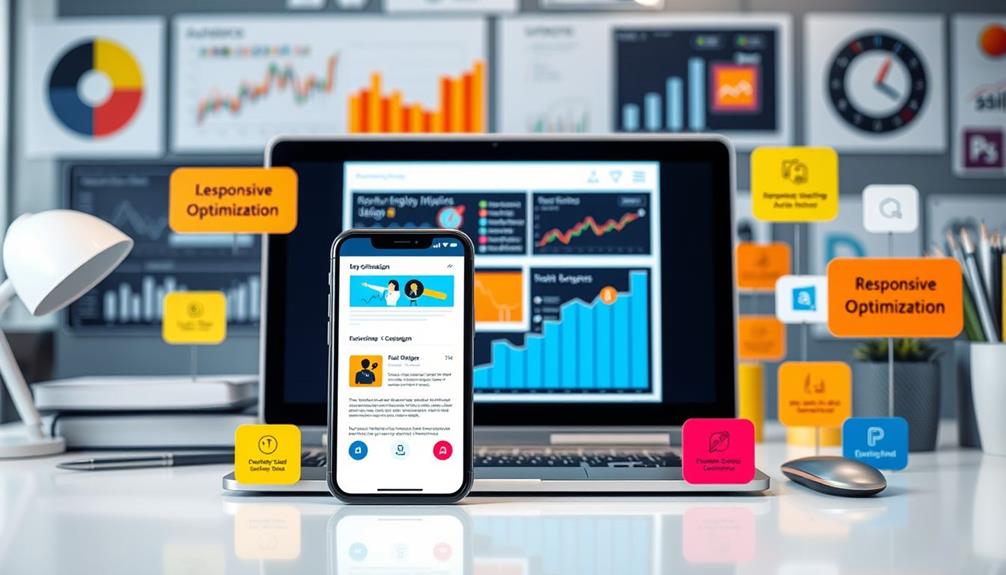
Mobile optimization is no longer optional; it's a necessity for successful email marketing. In 2022, 46% of marketing emails were opened on mobile devices, and this trend is only growing. To make the most of your email marketing software, focus on responsive email design that adapts to various screen sizes, ensuring your emails look great on all mobile devices.
By embracing an approach that nurtures an imaginative mindset, you can enhance your email marketing strategy and connect with your audience on a deeper level through creativity and empathy important aspects of design thinking.
Here are some techniques to boost your mobile optimization:
- Keep subject lines short (50-60 characters) for easy reading.
- Use bold, easy-to-click calls to action (CTAs) to enhance user experience.
- Personalize your marketing emails to increase engagement and relevance.
- Choose the best time to send your emails for maximum impact.
- Regularly measure the success of your campaigns to identify what works.
Despite the high mobile usage, 20% of email campaigns remain unoptimized, potentially losing engagement and revenue opportunities.
Most email service providers offer tools to help you create mobile-friendly designs. By implementing these mobile optimization techniques, you can boost your email marketing results and connect effectively with your audience.
Automation and Triggered Emails

Automation and triggered emails are game-changers in email marketing, allowing you to connect with your audience in a timely and personalized way. By leveraging automation, you can send targeted messages based on user behavior, with welcome emails achieving impressive open rates of 50% and click-through rates nearing 30%.
These triggered emails greatly boost your email marketing revenue, reportedly increasing income by at least 24 times and accounting for up to 20% of total revenue. In today's digital landscape, understanding the ethical implications of automated communications is essential for fostering public trust, similar to the role of an AI ethicist in shaping responsible technology use.
Effective campaigns often include welcome emails, cart abandonment reminders, and personalized birthday offers, ensuring you engage subscribers when it matters most. Over 70% of marketers use automated email sequences, but many still struggle with setting relevant triggers and managing message frequency.
To optimize your triggered email performance, A/B testing is essential. By comparing different approaches, you can refine your strategy and improve engagement rates based on user responses.
Ultimately, integrating automation and triggered emails into your marketing plan won't only enhance customer relationships but also drive substantial revenue growth. Embrace these tools and watch your email marketing efforts flourish.
Crafting Compelling Subject Lines
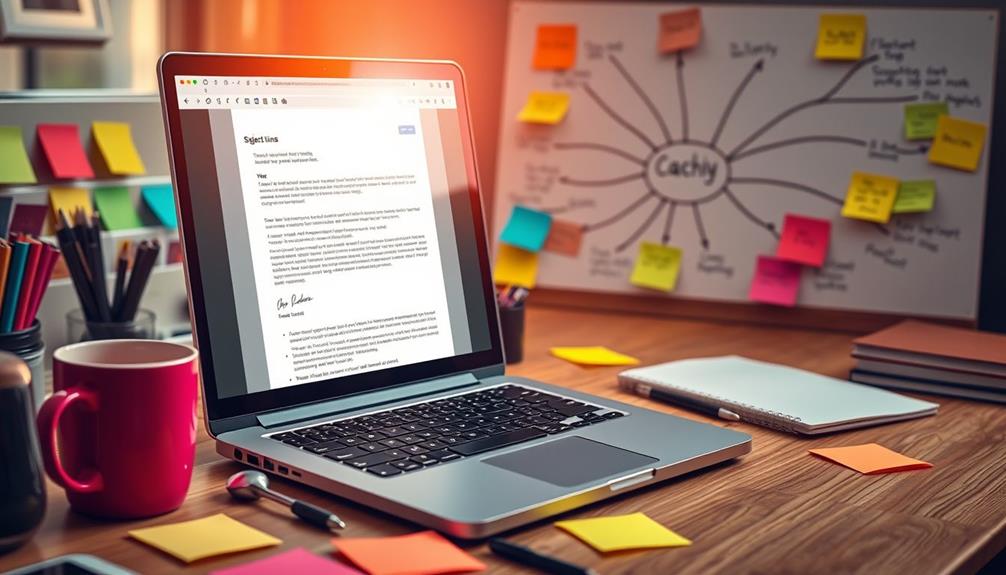
A strong subject line is your first chance to grab attention in a crowded inbox. Compelling subject lines can dramatically improve open rates, as 35% of recipients decide to open an email based solely on them.
To maximize engagement, consider these strategies:
- Personalize subject lines: Use the recipient's name to boost open rates by 26%. Additionally, incorporating elements of family photoshoot fails can add a touch of humor and relatability to your campaigns.
- Keep it concise: Aim for 50-60 characters for better readability, especially on mobile devices.
- Incorporate urgency: Phrases like "Limited Time Offer" create a sense of urgency that encourages quick action.
- Emphasize exclusivity: "Exclusive Access" makes recipients feel special and more likely to engage.
- A/B testing: Experiment with different subject lines to find which resonates best with your audience, leading to ongoing optimization of your email campaigns.
Timing Your Email Campaigns
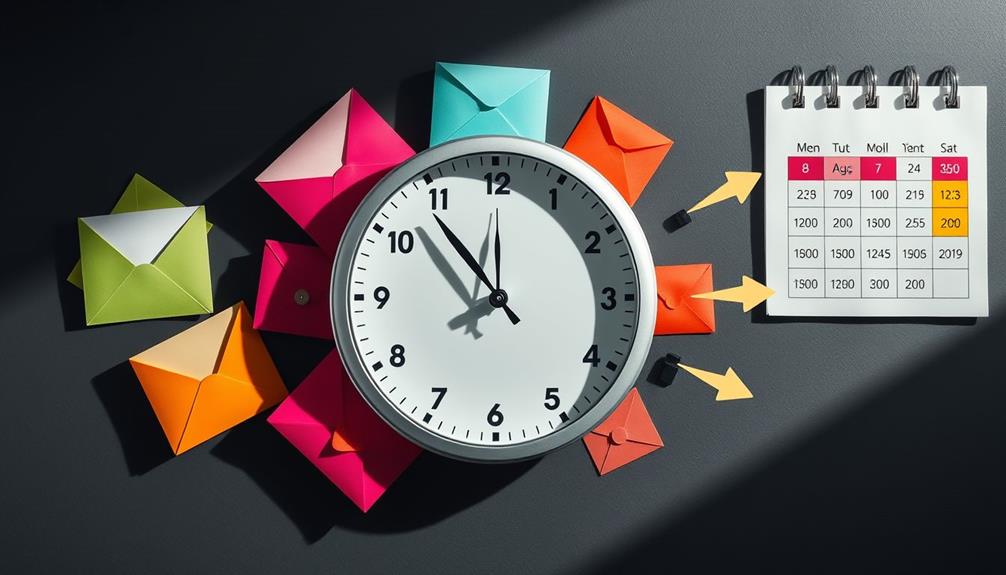
Understanding the right timing for your email campaigns can greatly impact your engagement rates. Analyzing audience behavior helps you identify ideal sending times. For example, emails sent between 4:00 am and 8:00 am achieve a remarkable 33% transaction rate.
A/B testing reveals that Tuesdays and Wednesdays often yield the highest open rates and engagement levels, so keep that in mind when planning your strategy.
When scheduling emails, don't forget to take into account time zones. You want your messages to reach recipients at their most convenient times. Monitoring open and click rates allows you to adjust your timing strategies based on real-time engagement data.
This feedback loop helps refine your approach continuously.
Utilizing Send Time Optimization tools can give you data-driven insights, ensuring you schedule emails at the most effective times. By taking the time to analyze these factors, you can greatly improve your email campaigns' performance.
Ultimately, the right timing can make all the difference in converting readers into loyal customers. So, pay close attention to these elements to maximize your email marketing success!
Frequently Asked Questions
What Is the Strategy of Email Marketing?
You should focus on building a targeted audience, personalizing your messages, and analyzing performance metrics. Engaging content, segmentation, and automation can greatly enhance your results, driving better engagement and higher returns from your efforts.
What Are the Four Types of Email Marketing?
Imagine a symphony of communication! You'll encounter promotional emails that entice, newsletters that inform, transactional emails that confirm, and nurturing emails that build relationships, each playing an essential role in your marketing journey.
What Are the 3 Main Steps in Email Marketing?
To succeed in your email efforts, focus on three main steps: build a targeted list, create personalized content that resonates, and analyze performance metrics. This approach will enhance your engagement and drive better results.
What Are the 5 Steps of Email Marketing?
Think of email marketing like planting seeds in a garden. You define goals, build your list, segment your audience, create engaging content, and analyze results. Each step nurtures growth and blossoms into successful campaigns.
Conclusion
In the world of email marketing, remember that "a stitch in time saves nine." By personalizing your messages, segmenting your audience, and optimizing for mobile, you're setting the stage for success. Keep an eye on your key performance indicators and use automation to streamline your efforts. Crafting compelling subject lines and timing your campaigns wisely can make all the difference. With these strategies, you'll not only engage your audience but also drive conversions and foster lasting relationships.

